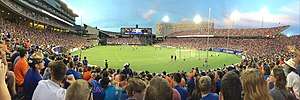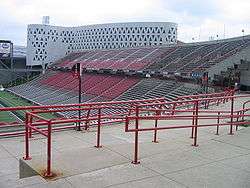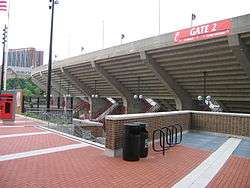Nippert Stadium
|
View from south corner in September 2015 | |
| Location |
2700 Bearcats Way (174 West Corry Street) Cincinnati, Ohio, U.S. |
|---|---|
| Coordinates | 39°07′52″N 84°30′58″W / 39.131°N 84.516°WCoordinates: 39°07′52″N 84°30′58″W / 39.131°N 84.516°W |
| Capacity |
|
| Record attendance |
40,124 (October 24, 2015) |
| Surface | Act Global UBU Sports Speed M6-M |
| Construction | |
| Broke ground | 1915 |
| Opened | 1915[1] (dedicated September 27, 1924)[2] |
| Renovated |
1936, 1954, 1970, 1990–1992, 2000, 2005, 2013–2015, 2017 |
| Construction cost |
$10.5 million ($150 million in 2018[3]) |
| Architect | Frederick W. Garber |
| Tenants | |
| |

Stadium

Stadium
Nippert Stadium is an outdoor stadium in Cincinnati, Ohio, on the campus of the University of Cincinnati. Primarily used for American football, it is the home field of the Cincinnati Bearcats football team. The stadium also hosts soccer, serving as the home of FC Cincinnati of the United Soccer League since 2016. Nippert Stadium has a seating capacity of approximately 40,000 people following an expansion and renovation in 2014. In rudimentary form since 1901, permanent concrete stands were built along each sideline for the 1915 season[1] and as a complete horseshoe stadium since 1924, making it the fourth-oldest playing site and fifth-oldest stadium in college football, respectively.[4]
Namesake
During the final game of the 1923 season with intrastate rival Miami University, UC player James Gamble Nippert sustained a spike wound injury. He died a month later of blood poisoning, reportedly due to having been infected by droppings left after a pre-game chicken race. Nippert's grandfather, James N. Gamble of Procter & Gamble, donated the required funds to complete the stadium. A locker room and training (medical) facility was added as part of the renovation for the safety of players.
Early history
In 1895, the organizer of UC's first football team, Arch Carson, introduced a plan to build a stadium complete with wooden bleachers on the site where Nippert Stadium currently stands. The plans became a reality in 1901 while Carson was serving as UC's physical education director. The first game played on the site originally called Varsity Field in Burnet Woods was on November 2, 1901 vs the Ohio University Bobcats. Cincinnati was defeated 16–0 in that contest. They rebounded a week later and defeated Hannover on Varsity field November 9, 1901, 10–0. Although Cincinnati has played home contests in other Cincinnati parks, this site has been the primary home of Cincinnati Football since that time. The playing surface at Nippert Stadium is called Carson Field in honor of Arch Carson. Construction of Carson Field began in 1900 and was completed in 1910.[5]
In 1915, construction was completed on the first sections of a brick and concrete structure to replace the wooden stands and continued for several seasons as funds were raised. In 1924, the completed structure was dedicated as James Gamble Nippert Memorial Stadium with a capacity of 12,000.
The field is slightly offset from a conventional north-south alignment, configured north-northeast to south-southwest at an approximate elevation of 800 feet (245 m) above sea level.
Timeline
- 1895 – UC physical education director Arch Carson introduced a plan to build a stadium in Burnet Woods.
- 1901 – Cincinnati played its first game on Carson Field. Wood bleachers were built on the surrounding hillside.
- 1909 – Lights were first used because the large number of co-op students on the team could practice only at night.
- 1915 – Construction began on a permanent brick-and-concrete structure.
- 1923 – James Gamble donated $250,000 in memory of his grandson, Jimmy Nippert, to complete the stadium. Jimmy died on Christmas 1923 from a football injury a month prior.
- 1924 – The completed James Gamble Nippert Stadium was dedicated on November 8, with a seating capacity of 12,000.
- 1936 – Carson Field was lowered 12 feet (3.7 m) to allow the capacity to expand to 24,000.
- 1954 – Reed Shank Pavilion was completed along the east sideline to boost the capacity to 28,000.
- 1968 – Nippert was the first home of the AFL's expansion Cincinnati Bengals while the city constructed Riverfront Stadium, which opened in 1970.
- 1970 – AstroTurf replaced the natural grass surface.
- 1989 – Nippert Stadium was closed for renovation and UC played its home games in 1990 at Riverfront Stadium.
- 1991 – Phase I of the stadium renovation was completed to allow for UC home games to be played. The structure was fortified and a three-tiered press box was added.
- 1992 – Phase II of the renovation was completed, increasing the seating capacity to 35,000 through the expansion of the (renamed) Herschede-Shank Pavilion, and adding new lighting and a scoreboard.
- 2000 – FieldTurf, a revolutionary new grass-like artificial surface, was installed. The former press box was renamed the John and Dorothy Hermanies Press Box.
- 2001 – A new video scoreboard was added in the north end zone and 10,000 seats were upgraded.
- 2005 – A permanent grandstand upgraded seating behind the north end zone and provided new locker rooms at field level for game use. A new, larger video board was installed and the FieldTurf playing surface was replaced.
- 2009 – 9,000 black cushioned seats were installed in the UCATS seating areas of the stadium, replacing the previously installed red plastic seating covers.
- 2013 – FieldTurf playing surface replaced with Act Global UBU and at the end of the 2013–2014 season with, Nippert closed for renovation.
- 2014 – UC plays home games at Paul Brown Stadium, home of the Cincinnati Bengals, during stadium renovations.
- 2015 – Capacity is increased to 40,000 with the addition of premium seating, new pavilion, additional restrooms, upgraded concessions and improved concourses.
- 2016 – New Turf,[6] renovation of visitors locker room[7] [8]
- 2017 – Playing surface expanded from 110 yards by 70 yards to 115 yards by 75 yards for soccer and player safety, resulting in the loss of 1200 seats. The $2M project was paid for by local USL club FC Cincinnati. [9], New Videoboard. The project was made possible by a gift from longtime UC supporters Carl and Martha Lindner. Longtime multimedia rights holder IMG College also contributed to the project. [10]
Renovation history
The field was lowered in 1936, allowing capacity to reach 24,000.
In 1954, a small upper deck on the East sideline was completed, and named the Reed Shank Pavilion. This increased capacity to 28,000.
In 1992, the stadium was heavily renovated, expanding the upper deck on the East sideline and adding a new Press Box on the West sideline. This increased capacity to 35,097.
In 2005, new gameday locker rooms behind the north end zone (underneath the newly completed Campus Rec Center) were added, as well as a new bigger video board above the north end zone.
2014–2015 renovation and expansion
As the UC program rose to prominence in the late 2000s, the small seating capacity of Nippert became an issue. Former UC head coach Brian Kelly called for an expansion of Nippert, the smallest stadium in the Big East Conference. On December 18, 2012, President Santa J. Ono and then Athletic Director Whit Babcock unveiled the long-anticipated plans to update and expand Nippert Stadium. Originally the price tag was estimated at $70 million,[11] but eventually an increased budget of $86 million was announced. On June 25, 2013, the University of Cincinnati Board of Trustees approved the Nippert Stadium Expansion. The West Pavilion now includes a new press box and premium seating area, which will add suites, loge boxes, and club seating. The western concourse also boasts improved general fan amenities, including concession stands, restrooms, and more efficient in-stadium traffic flow. Additions on the east side of the stadium were more sparse, but included additional concession stands, restrooms, and an expansion of the formerly-cramped concourse walkways, due to the addition of skywalks to connect the Herschede-Shank Pavilion with the O'Varsity Way brick plaza, which is located just outside the stadium.

After renovations, Nippert's capacity (including about 2500 SRO) is now around 40,000 (an exact figure hasn't yet been put forth by the university). However, local United Soccer League club FC Cincinnati sold out Nippert Stadium in July 2016 after the renovations, and announced a crowd of 35,061.[12] Further, in early 2017 Nippert lost 1200 seats in a $2 million project expanding the playing field 5 yards in both length and width to accommodate a full-sized soccer field.[13]
The 2014-15 renovation and expansion was designed by the New York-based firm, Architecture Research Office in close collaboration with Heery International. ARO served as the design architect, while Heery served as the sports consultant and executive architect.[14] Construction on the Nippert Stadium expansion started in December 2013, and was completed on time, in September 2015.[15] During the 2014 season, the Bearcats played all of their home games at Paul Brown Stadium, the downtown home of the Cincinnati Bengals.[16]
Attendance
Record attendance
On October 24, 2015, the Bearcats hosted the UConn Huskies on Homecoming weekend. The crowd on hand was 40,124 making this the second consecutive official sellout in the newly renovated Nippert Stadium.
Largest attendance (since 2000)
| Rank | Date | Attendance | Result | Win/Loss |
|---|---|---|---|---|
| 1 | October 24, 2015 | 40,124 | Cincinnati 37 – Connecticut 13 | W |
| 2 | October 1, 2015 | 40,101 | Cincinnati 34 – Miami (FL) 23 | W |
| 3 | September 15, 2016 | 40,015 | Cincinnati 16 – #6 Houston 40 | L |
| 4 | September 5, 2015 | 39,095 | Cincinnati 52 – Alabama A&M 10 | W |
| 5 | September 12, 2015 | 38,112 | Cincinnati 26 – Temple 34 | L |
| 5 | September 24, 2016 | 38,112 | Cincinnati 27 – Miami (OH) 20 | W |
| 7 | November 5, 2016 | 37,522 | Cincinnati 3 – BYU 20 | L |
| 8 | August 31, 2013 | 36,007 | Cincinnati 42 – Purdue 7 | W |
| 9 | September 30, 2017 | 35,736 | Cincinnati 21 – Marshall 38 | L |
| 10 | September 22, 2018 | 35,220 | Cincinnati 34 – Ohio 30 | W |
Soccer attendance
During FC Cincinnati soccer matches, stadium capacity was limited to 35,061 before 2017 when the field was widened and rows were removed along the sidelines and in the corners to acccomodate a regulation width soccer field. Nippert sold out once for a soccer match before the field was widened, when English Premier League club Crystal Palace FC played a friendly against FC Cincinnati on July 16, 2016. Current soccer capacity after rows were removed is approximately 33,800.
| League | Season | Average attendance |
|---|---|---|
| USL | 2016 | 17,296 |
| USL | 2017 | 21,199 |
| USL | 2018 | 25,194 |
Praise


Nippert has earned a reputation as a tough place to play. One national columnist, visiting the sold-out Keg of Nails rivalry game in 2013, described Nippert Stadium as a "quaint bowl of angry noise sitting under the gaze of remarkable architecture" and went on to compare it to a "baby Death Valley" (referring to LSU's notoriously intimidating Tiger Stadium).[17] In 2012, USA Today called Nippert Stadium the best football venue in what was then the Big East Conference.[18]
Other tenants and events hosted
The stadium served as home for the American Football League expansion team, the Cincinnati Bengals, in 1968 and 1969, while their eventual permanent home at Riverfront Stadium was being constructed.
The Cincinnati Comets of the American Soccer League played at Nippert in 1973.[19]
The stadium has served as a concert venue at least three times. On July 22, 1973 a show headlined by The Edgar Winter Group with The James Gang and Peter Frampton's group, Frampton's Camel, drew between 5,000 and 7,000 fans.[20] On July 29, 1973 a concert with Grand Funk Railroad drew only 8,000 fans; seventeen were arrested on charges they got in without a ticket.[21] On August 3, 1975, Nippert hosted The Ohio River Rock Festival (Aerosmith, Black Oak Arkansas, Blue Öyster Cult, Foghat, Mahogany Rush, Nitty Gritty Dirt Band, REO Speedwagon, and Styx; admission was festival seating/general admission, attendance 32,000 est. according to local radio broadcasts).
On November 2, 2008, Democratic Presidential candidate Barack Obama held a rally at Nippert two days before the election to an estimated 27,000 attendees.[22]
FC Cincinnati began playing at Nippert in 2016. The team broke the United Soccer League regular-season record for attendance five times, drawing 30,417 fans to its game against New York Red Bulls II on September 16, 2017. They drew 30,187 to their playoff game against the Charleston Battery on October 2, 2016. On September 29, 2018, they once again broke the USL attendance record, drawing 31,478 fans against the Indy Eleven. The team drew 35,061 for a friendly against Crystal Palace F.C. on July 16, 2016. They drew a USL record home opener crowd of 23,144 against Saint Louis FC on April 15, 2017. They drew 33,250 to a U.S. Open Cup semifinal against New York Red Bulls on August 15, 2017.
Nitro Circus performed at Nippert on June 23, 2018.[23]
Alternative stadiums
UC has used Paul Brown Stadium, home of the NFL's Cincinnati Bengals, as an alternate home field for several high profile home games. The downtown stadium has a larger seating capacity of 65,535. Games against Ohio State (2002), Oklahoma (2010), and West Virginia (2011) drew crowds of 66,319, 58,253, and 48,152, respectively, at Paul Brown Stadium. Whit Babcock didn't rule out the occasional home game to be played at Paul Brown Stadium, but made it known that the school is in favor of staying at Nippert Stadium.
See also
References
- 1 2 http://grfx.cstv.com/photos/schools/cinn/sports/m-footbl/auto_pdf/2015-16/misc_non_event/15_fb_guide.pdf
- ↑ 1924 Cincinnati Bearcats Archived 2015-12-01 at the Wayback Machine.
- ↑ Federal Reserve Bank of Minneapolis Community Development Project. "Consumer Price Index (estimate) 1800–". Federal Reserve Bank of Minneapolis. Retrieved January 2, 2018.
- ↑ "Nippert Stadium facts, 2015 "Archived copy". Archived from the original on 2015-09-19. Retrieved 2015-05-17.
- ↑ "Nippert Stadium - UC Historical Walking Tour". sites.google.com. Retrieved 4 April 2018.
- ↑ "Nippert Stadium Turf Project Is Underway". GoBearcats.com. CBSi Advanced Media. Retrieved 4 March 2016.
- ↑ "FC Cincinnati makes changes to Nippert Stadium". Cincinnati Business Courier.
- ↑ Bach, John (March 2015). "Coming home". UC Magazine. Retrieved May 17, 2015.
- ↑ "UC & FC Cincinnati Announce Additional Nippert Stadium Renovations". GoBearcats.com. CBSi Advanced Media. Retrieved 25 January 2017.
- ↑ "Nippert Stadium Set For New Videoboard". GoBearcats.com. CBSi Advanced Media. Retrieved 3 August 2017.
- ↑ "Cincinnati Enquirer - cincinnati.com". Cincinnati.com. Retrieved 4 April 2018.
- ↑ "Festive Crowd of 35,061 on Hand For Cincy's Loss to Palace". fccincinnati.com. Retrieved 8 January 2017.
- ↑ "Details on FC Cincy's changes to Nippert". cincinnati.com. Retrieved 8 January 2017.
- ↑ "PHOTOS: An Inside Look At The Brand New Nippert Stadium". urbancincy.com. 18 September 2015. Retrieved 4 April 2018.
- ↑ "Nippert Stadium Expansion FAQ". gobearcats.com. Retrieved 25 June 2013.
- ↑ Groeschen, Tom (12 August 2013). "UC officially announces 2014 games at Paul Brown". Cincinnati Enquirer. Archived from the original on 25 August 2013. Retrieved 14 August 2013.
- ↑ December 2013 "The Keg of Nails, where getting out is half the battle" Check
|url=value (help). - ↑ August 2012 "USA Today Names Nippert Stadium Best in Big East" Check
|url=value (help). - ↑ "Cincy ASL Games To Be At Nippert"|The Plain Dealer, Cleveland, Ohio|April 8, 1973, page 11-C.
- ↑ "Heavy metal, Tin ears at Nippert Stadium"|The Cincinnati Post, Cincinnati, Ohio|July 23, 1973, page 25.
- ↑ "Gate Crashers Charged"|The Plain Dealer, Cleveland, Ohio|July 31, 1973, page 8-C.
- ↑ Rulon, Malia; Coolidge, Sharon (November 2, 2008). "Obama: Change 'two days' away". Cincinnati Enquirer. Archived from the original on August 27, 2012. Retrieved August 27, 2012.
- ↑ "CINCINNATI, OHIO Nitro Circus". nitrocircus.com. Retrieved June 25, 2018.
External links
| Wikimedia Commons has media related to Nippert Stadium. |
- Nippert Stadium – Home of Bearcat Football
- Photographs of Nippert Stadium
- Nippert Stadium Expansion Renderings
- Nippert Stadium Presidential Suite Tour
| Preceded by First stadium |
Home of the Cincinnati Bengals 1968–1969 |
Succeeded by Riverfront Stadium |
